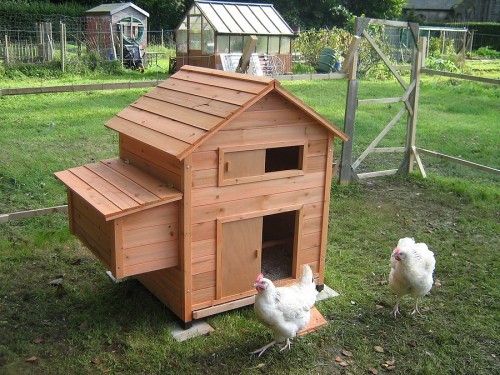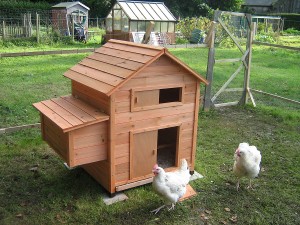By Melissa Wynn
So, you’ve decided to raise chickens. What comes next? First you need to choose a breed that meets the criteria of your needs. Some are good egg layers but not best for the stew pot. Others are better for meat but not so much for eggs and many breeds are just fine for both. (See Critters page this issue)
Will you start with adult birds or downy baby chicks? Like all babies new chicks need special attentive care. The first week chicks need to kept very warm, 90-100 degrees. Each week that follows the temperature is lowered by five degrees. This means the chicks will need an enclosed well ventilated space called a brooder. Several commercial models are available but a brooder can be as simple as a sturdy cardboard box. Small brooders are easily heated with a 100 watt light bulb pointing into one corner. Your brooder should allow for each chick to have at least one square foot of space as they grow quickly. A floor covering for the brooder , such as pine shavings, is also needed. Like their adult chicken parents chicks love to scratch and peck at the ground. On nice days start introducing your chicks to the great outdoors. Section off a small area so that they are easy to catch when it is time to come back inside. Handling your chicks when they are little helps them get used to being caught and moved around. Always wash your hands after handling your chicks and after cleaning their areas. Of course all living things need food and water. Locals in our area can pick up chick crumbles and starter feed blends as well as water dispensers and even the chicks themselves from the Pardner at 702-100 Johnstonville Rd in Susanville.
After the first two months the chicks are ready to move outside to a chicken coop. Chickens are very vulnerable to predators so your chicken coop and hen house need to be sturdy. Skunks, fox and coyotes are all good at digging and love to eat chickens so be sure that the floor and perimeter of your chicken coop has a liner such as chicken wire to prevent entry from tunneling. A wire covering over the coop is a good idea as many predators are also good fence climbers. There are endless options for designing your hen house but each should have plenty of nesting boxes for egg laying. Pine shavings or straw make excellent bedding for the boxes. Many designs have “back doors” allowing you to reach into each nesting box from the outside when gathering eggs.
Adult chickens will require a food change as well. Many varieties are available to help enhance egg laying or quicker growth for meat production. Ask our friends at the Pardner or your own local feed store which feed is right for your birds. Chickens also enjoy a treat of veggie scraps or bread crumbs now and then. Happy chickens are healthy chickens.
Chickens can fill your fridge with fresh, organic eggs and poultry, entertain you as a pet or take you to exotic breed competitions. They can be a load of fun but are also a big responsibility. They are messy, noisy and require regular maintenance and care. Before you decide that back yard chickens are for you do your home work and check your local codes to be sure it is allowed in your town or city.
Facts Courtesy of The Pardner and backyardchickens.com













